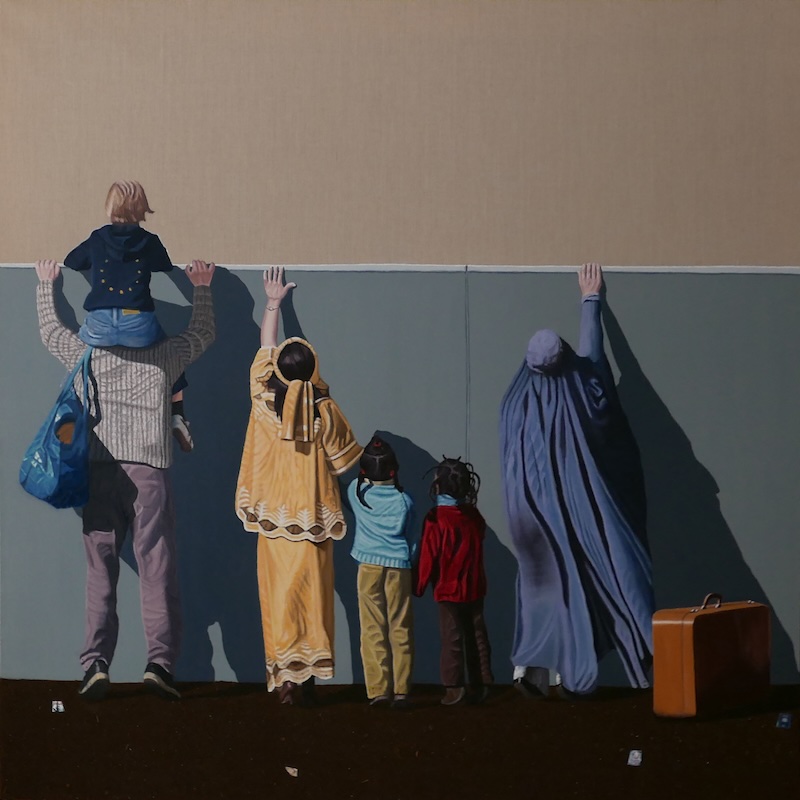
To benefit Amnesty International Italy | A favore di Amnesty International Italia
The Wall
140cm x 140cm
Price
20,000 EUR
Description
Antonio Cacciatore
2016
The Wall
Oil on canvas, soil, photo collages and SIM card
140 cm x 140 cm
The proceeds of sale of the artworks will be split 50/50 between Amnesty Italy and the Artists.
Antonio Cacciatore
2016
Il Muro
Olio su tela, terra, collage di foto e carta SIM
140 cm x 140 cm
Il ricavato della vendita delle opere sarà suddiviso al 50% tra Amnesty Italia e gli Artisti.
Catalogue Note
In October 2015, I traveled to the island of Lampedusa, which is part of the Sicilian province of Agrigento, the land of my parents’ origin. This region, once a point of departure in the 1950s and 1960s, has become — through a twist of history — a gateway into Europe at the heart of the Mediterranean.
In this video, I wanted to bring together and create a dialogue between external, public documentary sources and the elements I personally collected on the island. The infographic depicting shipwrecks of migrant boats in the Mediterranean from January 2002 to November 2016, along with audio recordings of distress calls made to the Lampedusa coast guard, form the raw documentary material.
The footage I captured in Lampedusa in October 2015 reflects my search for traces or echoes — real or symbolic — rooted in Sicilian culture and colliding with the island’s current reality. One such example is the legend of Andrea Anfossi, a captive who escaped at sea on a makeshift raft and inspired the cult of the Madonna of Lampedusa, the protector of those who take to the sea.
The video is presented in a dual-screen format, placing the two sources side by side.
Il terreno reale in primo piano àncora il dipinto allo spazio fisico dello spettatore. Le immagini incastonate in questa terra sono riproduzioni di foto portate a riva sulle spiagge dell’isola greca di Lesbo alla fine del 2015.
La carta SIM simboleggia il fragile filo che collega i migranti alle persone care che hanno lasciato. Il telefono cellulare è anche uno strumento vitale utilizzato per inviare richieste di soccorso dalle imbarcazioni dei migranti nel Mediterraneo.
Nell’ottobre 2015 mi sono recata sull’isola di Lampedusa, che fa parte della provincia siciliana di Agrigento, terra d’origine dei miei genitori. Questa regione, un tempo punto di partenza negli anni Cinquanta e Sessanta, è diventata – grazie a un colpo di scena della storia – una porta d’accesso all’Europa nel cuore del Mediterraneo.
In questo video ho voluto riunire e creare un dialogo tra le fonti documentarie esterne e pubbliche e gli elementi che ho raccolto personalmente sull’isola. L’infografica che illustra i naufragi di imbarcazioni di migranti nel Mediterraneo dal gennaio 2002 al novembre 2016, insieme alle registrazioni audio delle richieste di soccorso fatte alla guardia costiera di Lampedusa, costituiscono il materiale documentario grezzo.
Le riprese effettuate a Lampedusa nell’ottobre 2015 riflettono la mia ricerca di tracce o echi – reali o simbolici – radicati nella cultura siciliana e in collisione con la realtà attuale dell’isola. Un esempio è la leggenda di Andrea Anfossi, un prigioniero che fuggì in mare su una zattera di fortuna e che ha ispirato il culto della Madonna di Lampedusa, protettrice di coloro che prendono il mare.
Il video è presentato in un formato a doppio schermo, affiancando le due fonti.